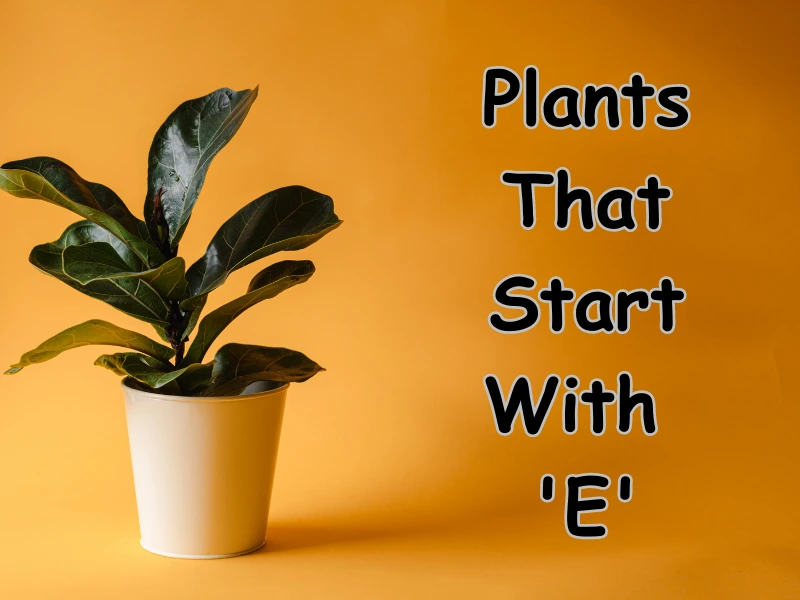
Introduction
Plants starting with the letter “E” encompass a broad spectrum of species, each with its unique features and traits. From elegant flowering plants to resilient evergreens, the list is diverse and exciting. Whether you’re interested in adding beauty to your garden or seeking useful herbs, the E plants have something for everyone.
Echinacea (Echinacea purpurea)
Echinacea, commonly known as purple coneflower, is a stunning perennial flower cherished for its vibrant pink to purple daisy-like blooms. It thrives in well-draining soil and requires ample sunlight. Echinacea is popular for its medicinal properties, as it is believed to boost the immune system. Gardeners can enjoy the sight of pollinators like butterflies and bees visiting their Echinacea patches.
Elephant Ear (Colocasia esculenta)
The Elephant Ear plant is an attention-grabbing tropical plant known for its large, heart-shaped leaves that resemble an elephant’s ear. It is ideal for creating a dramatic focal point in your garden or indoor space. Elephant Ear thrives in moist, well-draining soil and prefers partial shade. Be cautious in colder regions, as it is sensitive to frost.
English Ivy (Hedera helix)
English Ivy is a classic evergreen vine that is famous for its ability to climb walls, trellises, and trees. This plant is well-loved for its lush, green foliage and is an excellent option for adding greenery to vertical spaces. English Ivy is relatively low-maintenance and can tolerate shade, making it a versatile choice for various garden designs.
Eucalyptus (Eucalyptus spp.)
Eucalyptus trees are iconic for their aromatic leaves and towering presence. They are native to Australia but have been planted in many parts of the world. Eucalyptus leaves are often used in essential oils for their therapeutic properties, and the wood is valued for its durability and strength. These trees require full sun and well-draining soil.
Euonymus (Euonymus fortunei)
Euonymus, commonly known as wintercreeper, is a versatile evergreen shrub perfect for creating hedges or ground covers. It has variegated leaves, adding a splash of color to your garden throughout the year. Euonymus is relatively low-maintenance and adaptable to various soil conditions.
Echeveria (Echeveria spp.)
For succulent enthusiasts, Echeveria is a must-have. These charming rosette-shaped succulents come in various colors, from pastel pinks to striking blues. They are easy to care for and prefer well-draining soil with bright sunlight. Echeverias are popular for container gardening and can also be grown indoors.
Elderberry (Sambucus spp.)
Elderberry bushes are known for their clusters of small, dark berries that are used to make jams, syrups, and medicinal remedies. They are rich in antioxidants and have immune-boosting properties. Elderberries thrive in well-draining soil and require regular pruning to maintain their shape.
Euphorbia (Euphorbia spp.)
Euphorbias are a diverse group of plants that range from tiny succulents to large shrubs. They have unique shapes and textures, making them attractive additions to any garden. Some Euphorbias produce milky sap that can be irritating to the skin, so handle them with care. These plants generally prefer bright light and well-draining soil.
Edelweiss (Leontopodium alpinum)
Edelweiss is a beautiful alpine plant known for its star-shaped white flowers with a woolly appearance. It symbolizes love and courage and has become a symbol of the Alps. Edelweiss thrives in rocky, well-draining soil and prefers cooler temperatures.
Eggplant (Solanum melongena)
Eggplant, also known as aubergine or brinjal, is a popular vegetable in many cuisines worldwide. This warm-season plant produces glossy, purple fruits that are delicious in various dishes. Eggplants thrive in warm climates and well-draining soil with ample sunlight.
Evening Primrose (Oenothera biennis)
Evening Primrose is a charming wildflower with bright yellow blooms that open in the evening, giving it its name. The plant has medicinal properties, and the seeds are a source of essential fatty acids. Evening Primrose prefers well-draining soil and thrives in sunny locations.
Elm Tree (Ulmus spp.)
Elm trees are majestic deciduous trees that have a long history of being used in landscaping and as shade trees. They have serrated leaves and produce small, winged seeds known as samaras. Elms prefer well-draining soil and full sun to partial shade.
Conclusion:
Exploring plants that start with the letter “E” has been an exciting journey through a diverse range of flora. From enchanting flowers to practical edibles, these plants offer something for every gardening enthusiast. As you embark on your plant-growing adventures, remember to consider each plant’s specific needs, such as sunlight, soil type, and water requirements, to ensure they thrive in your garden or indoor space. Happy gardening!
FAQs:
Q1: Can I grow Echinacea in containers? Yes, Echinacea can be grown in containers. Ensure the pot has good drainage, and use a well-draining potting mix. Place the container in a sunny spot for best results.
Q2: Is English Ivy invasive? English Ivy can be invasive in some regions, so it’s essential to monitor its growth. Consider planting it in containers or using non-invasive varieties if you’re concerned about its spreading.
Q3: How often should I water Echeveria? Allow the soil to dry out between waterings. Depending on the climate and season, water your Echeveria every 1-2 weeks.
Q4: Are all Euphorbias succulents? Not all Euphorbias are succulents, but many of them are. Some Euphorbias are herbaceous plants or shrubs.
Q5: Can I grow Edelweiss in a warm climate? Edelweiss prefers cooler temperatures and is best suited for alpine or mountainous regions. In warm climates, try growing it in a partially shaded location.

